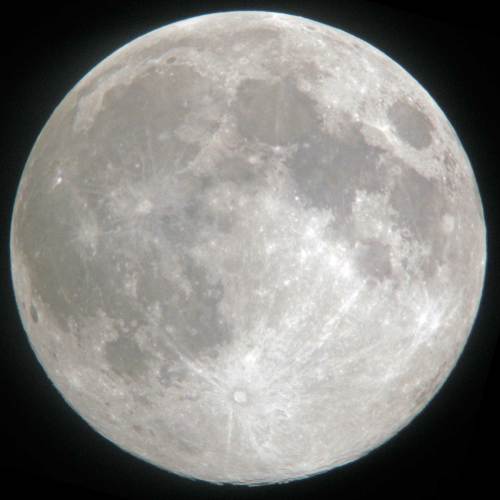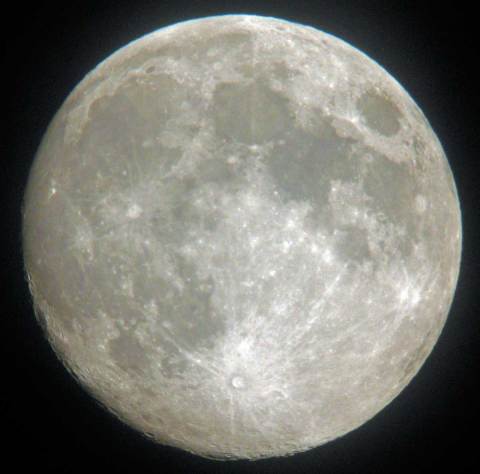This year’s Harvest Moon comes 11 days before the equinox; that’s almost as early as they can come! Harvest Moon is typically defined as the closest full moon to the September equinox; a few more days and we’d be having an October Harvest Moon instead of an early September one.
It’s called the harvest moon because of a lovely celestial coincidence that occurs in the autumn. Normally the full moon rises about an hour (50 minutes) later every evening. But around the September equinox, the angle of the moon’s orbit with the horizon is such that the moon rises only about 25 to 30 minutes later at midtemperate latitudes, and only 5 to 10 minutes later in the far north.
For example, at my latitude (almost exactly 26°N), on the three full and near-full moon nights in September, a nice big moon rises at 6:55 p.m. on the 11th, 7:27 p.m. on the 12th, and 7:59 p.m. on the 13th. Those times are clustered right around the official time of sunset on those days (7:28, 7:27, and 7:26, respectively). Before the days of electricity (and Congress’s wonderful daylight “saving” time), the extra light given off by that full moon might have been a big help to farmers working long days trying to get a crop in.
Of course, the effect is even more pronounced the farther north you go. In Boston, latitude 42°N, the moon rises at 5:57, 6:21, and 6:45; sunset is at 5:02, 5:00, and 4:58. Up in Anchorage, the moon comes up at 7:45, 7:51, and 7:58, while the sun goes down at 6:35, 6:31, and 6:28.
Did you notice how much faster the sunset times diverge up north, while they’re only 1 minute apart down here near the tropics? Winter comes on a lot faster with darkness moving so swiftly…
You might think that this year’s harvest moon would be a bit disappointing for illumination, because it’s near apogee, when it will be about as far away as it can get in its orbit (406067 km this month, on the 15th); its angular size will be only 29 minutes and change, instead of the full 34 minutes of full moons near perigee (357555 km this month, on the 28th). But when you do the math, you discover that the maximum difference in intensity of moonlight between apogee and perigee is about 30% (which is not all that much, given how the human eye responds to the intensity of light).
It’ll be a short while (May 6, 2012) before the moon’s orbit lines up perigee and a full moon again, as happened with this year’s “super moon” in March, although the distance next time (356953 km) will be a whopping 376 km farther from us than it was earlier this year (356577 km).
Here’s what the difference between the moon at perigee and apogee looks like visually, courtesy of NASA’s fabulous astronomy picture of the day website (APOD):

I would have pasted in some prettier pictures, but they are copyrighted by some of the best lunar photographers of our day (Anthony Ayiomamitis and Antonio Cidadao)
Anyhoo, here is this month’s full (well, nearly) moon picture from Boca Raton, FL:
Libration in latitude is a full 6.5°S, nearly maximal, so the South Pole is quite well situated for observation this time around—or it would be, if the full moon were at all a convenient time to explore the highlands of the southern moon! Much better is to await a good first- or third-quarter moon with a similar libration, if you’re trying to find some of the features in this libration zone, like Bailly, Drygalski, Hausen, Scott, Shackleton, etc.
Even just one night earlier, and with much more clouds making focusing next to impossible, the details of the southern highlands are much more evident:
You can also tell that the moon’s libration in latitude seems slightly less at this full than the previous night. The combined effects of a lunar terminator and a bit more tilt towards us just serve to underscore the astronomer’s wisdom that it’s best to explore the skies before or after full moon…
An interesting note that I’d not thought to keep track of before: according to the NOAA table of azimuths, tonight the moon rose about 92° east of north, or about 2° south of east. In a couple of weeks (well, 12 days), on the equinox, the moon will rise only 72° east of north, or about 20° north of east. I’ve known for years how the moon’s course in a month is like the sun’s course over the entire year, but working it out in my head really makes it dramatic.



